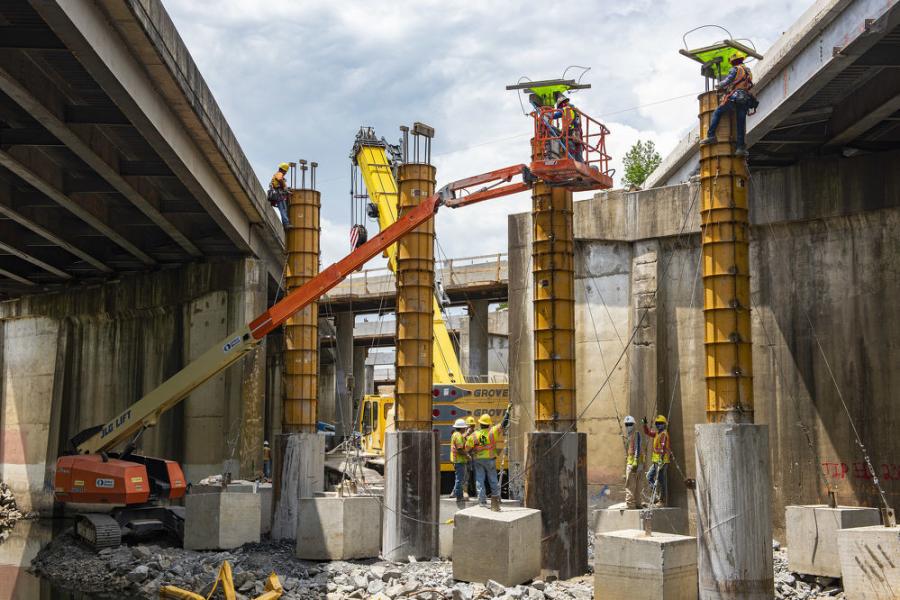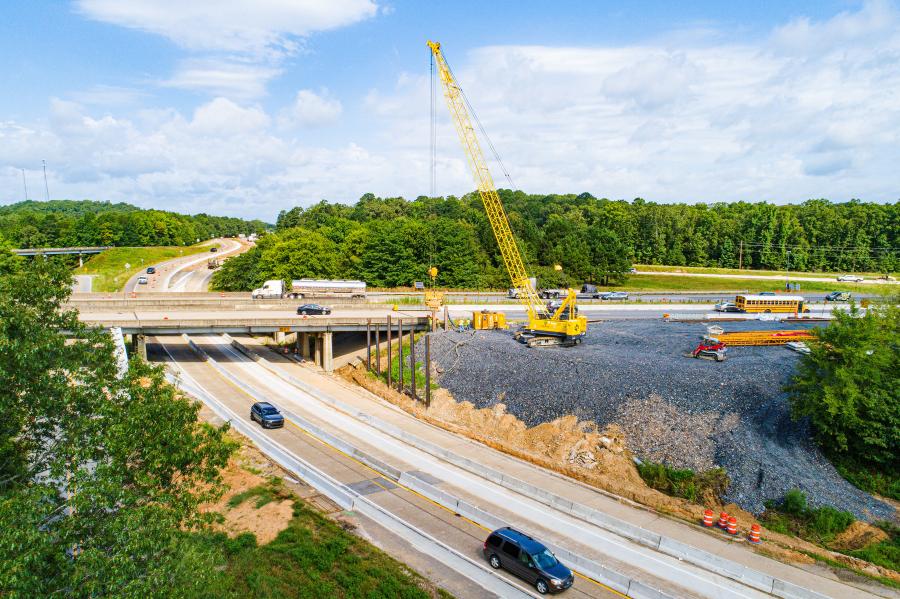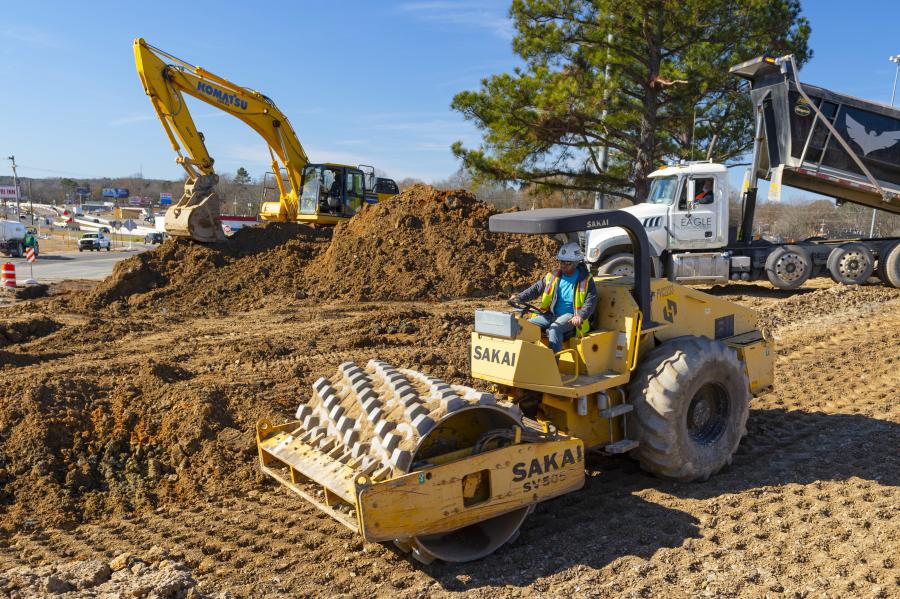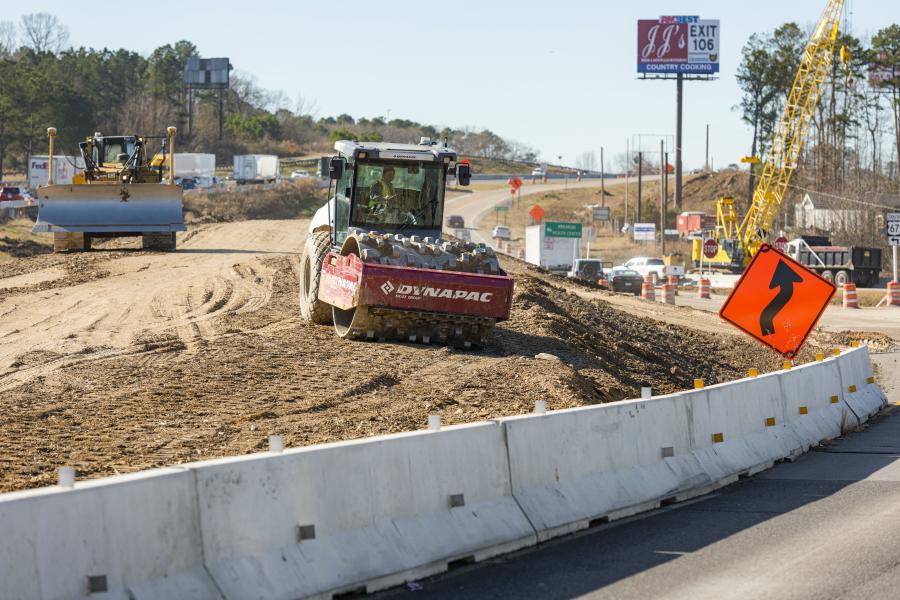A new bridge at South Street has already been completed, with ramps for an eventual interchange currently being built.
(ARDOT/Rusty Hubbard photo)
A record-setting $188 million project that will widen almost 5.5 mi. of Interstate 30 is under way in Saline County, Arkansas. Crews also are tasked with reconstructing three interchanges and replacing five existing bridges.
"The work will aid in reducing congestion for this section of I-30, as well as replacing bridge structures which have become structurally deficient," said Tom Fisher, ARDOT alternative delivery project manager. "The existing I-30 pavement structure is severely fatigued, and will be removed and replaced with Portland Cement concrete pavement."
As the single-largest contract ever awarded by the Arkansas Highway Commission, the effort is a major undertaking.
"The section of interstate being replaced is one of the most heavily traveled routes in Saline County," said Fisher. "The pavement structure for the interstate roadway is 14-foot PCC pavement, with a one-inch asphalt bond breaker supported by six inches of cement stabilized crushed stone base course for the sub-base.
"The pavement will require more than 162,000 cubic yards of concrete pavement. The five bridges being constructed total more than 3,800 cubic yards of substructure concrete, or Class S concrete, and more than 9,000 cubic yards of superstructure concrete, as well as over eight million pounds of structural steel."
The ongoing construction will serve the traveling public on I-30 from log mile 111 to 116, from the Hwy 70 Interchange to the Sevier Street Interchange.
"Along with the Hwy 70 Interchange, the Hwy 67 and South Street Interchanges are being reconstructed, as well as the Frontage Roads," said Fisher. "Saline County residents will see a benefit, as well as those traveling on Interstate 30."
It's anticipated that by 2038, average daily traffic will total approximately 130,000 vehicles. The existing lane configuration of I-30 will be maintained throughout construction; however, lane widths have been reduced from 12 ft. wide to 11 ft. wide. The widening and bridge construction areas are protected by precast concrete barrier walls, with speed limits reduced to 60 mph throughout the project.
Lane closures are allowed on I-30 in eastbound lanes from 9 p.m. to 5 a.m. and westbound from 10 p.m. to 6 a.m. Lane closures are allowed on Hwy 70, Hwy 67, West South Street and I-30 Frontage Roads from 9 p.m. to 6 a.m.
Fisher said the project will improve transportation connections, as well as increase capacity for the re-constructed routes.
"The current four lanes of Interstate 30 will be widened to six lanes. South Street will include a roundabout to allow free flow traffic, and the Hwy 67 Interchange [Exit 144] will be reconstructed to improve intersections and interstate ingress/egress.
The project's eastern construction limits will connect with the existing six-lane portion of Interstate 30 at Sevier Street, which has experienced congestion issues because of the existing lane drop and merging traffic. Additionally, the existing interstate pavement has deteriorated substantially, which has resulted in a rough driving surface. The replacement of the existing roadway will improve the pavement smoothness, as well as the lifespan of the roadway.
The job was let in December 2018 and was awarded to Johnson Brothers Corporation in January 2019. The project was bid with 1,290 calendar days, and has an estimated completion date of December 2022. Fisher noted that Johnson Brothers is part of its parent company, Southland Holdings, which has more than $8.4 billion in active projects.
"They are able to self-perform the majority of construction, which yields time and cost savings to the department, taxpayers and the traveling public."
According to Aaron Peck, Jacobs Engineering resident engineer, "Traffic is always a challenge. Successfully building a project and keeping both travelers and workers safe is important. For a project of this size, there's also a large amount of dirt that needs to be removed and placed within different areas of the project."
Roughly 600,000 cu. yds. of dirt will be excavated and placed during the construction. Right now, excavation and grading are taking place, along with concrete paving and bridge work.
Several erosion control measures are in use on the project. They include sand bag and rock ditch checks; silt fence and drop inlet silt fence; curb inlet protection; sediment basins; erosion control matting; and temporary and permanent seed.
A new bridge at South Street has already been completed, with ramps for an eventual interchange currently being built. The new eastbound bridge over Hwy 70 is finished, as well.
"There will be two new bridges that cross the Saline River, an eastbound and a westbound bridge," said Peck. "The westbound bridge is partially complete, but the eastbound bridge has not yet started. In addition, there are three bridges that cross the Saline River Relief. One will be eastbound and two westbound, including one for westbound traffic, the other for traffic exiting at 114. The bridge for those exiting is complete, the new westbound bridge is under construction and the eastbound bridge has not yet started."
As for realigning the interchange and ramps at U.S. Highway 67, the interchange does not change a lot, with the exception of the northeast quadrant (the ramps for traffic exiting WB I-30 and the ramp from NB Hwy 67 to I-30 WB). The other ramps will be close to where they are currently located, with some minor adjustments. One significant change motorists will notice is where the westbound exit ramp meets Hwy 67. It will become a signalized intersection.
Heavy machinery at the job site includes bulldozers, excavators, cranes, motor graders, dump trucks, compaction equipment, concrete paving equipment, concrete trucks and asphalt paving equipment.
Peck noted that a great deal of planning was necessary in order to carry out the widening effort in the most efficient way possible.
"The additional lane is going in the existing median, and so we're able to get an extra lane in each direction without making the roadway wider."
Regarding the roundabout at South Street on the westbound I-30 frontage road, said Peck, "This work is currently under construction. A portion of the new pavement has been built, and traffic has been routed onto a portion of this new pavement so that the remaining roundabout can be completed."
The project is included in the Connecting Arkansas Program (CAP), a 10-year, half-cent sales tax program to improve the state's intermodal transportation system. The CAP was created through a voter-approved constitutional amendment, passed by the people of Arkansas in 2012, which includes construction that widens and improves approximately 200 mi. of highways and interstates. Federal funds also are being used to complete construction.
The project involves a lot of hard work, but Peck saidthe long hours for crews are worth it.
"It's always rewarding to be a part of something that helps the local area." CEG
Today's top stories




























